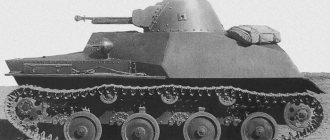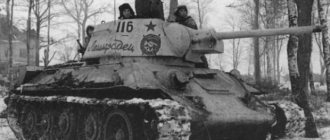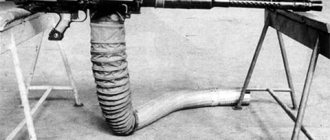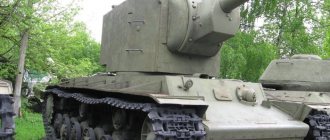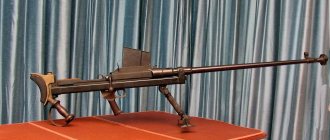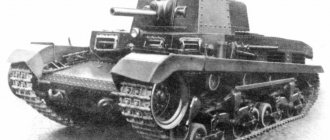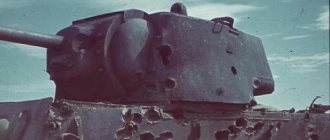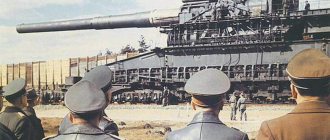Sherman tank
The American-made Sherman medium tank went through several wars of the 20th century, but it gained worldwide fame during the Second World War, becoming one of the most popular medium tanks in the world, second only to the Soviet T-34 and T-54. This tank got its name from the British, who gave it in honor of the American General William Sherman, since M4 model tanks were supplied to Britain in large quantities.
The Sherman M4A2 tank was also very familiar to Russian tankers. Under Lend-Lease, the United States supplied the Soviet army with about 4,000 M4 Sherman tanks equipped with diesel engines. It was considered a great success to serve on the American Sherman tank, since its level of comfort was an order of magnitude higher than any Soviet-made tank. The coffee maker, which was considered standard equipment and was installed inside the M4A2 tank, made a huge impression on Soviet tank crews.
Sherman Monument
The history of the Sherman tank, how it appeared and why it became so popular
The history of the appearance of the Sherman tank began back in 1939. It was then that the Americans decided to develop their own medium tank, since there were about three hundred medium tanks in the entire US Army, and the European tank armadas made a huge impression on the Americans.
The first American tank was the M2. This tank did not participate in battles, since its weapons and armor were too weak. Realizing that a medium tank was of little use without a powerful gun, American designers developed the M3 Lee medium tank. This one had a good gun, but its maneuverability was severely limited, which was unacceptable for medium tanks. American designers had to urgently develop a new combat vehicle. The transitional model between the M3 and M4 Sherman was a prototype, designated T6, whose design used components from the M3 and a fundamentally new layout.
Shermans in service
In 1942, a new medium tank, the M4 Sherman, appeared. In addition to the M4A2 modification (which was supplied to the USSR), there were 7 different modifications, among which was the famous M4A3E8 Sherman tank. In addition, many special combat vehicles and self-propelled guns were built on the basis of the M4.
Large target
The fact that the Sherman was a spacious tank is both a plus and a minus. “American” is significantly taller than its Soviet counterpart (the height of the “Sherman” is 3 meters, and the T-34 is 2.3 meters). Consequently, it was a more convenient target for enemy shells. Perhaps this circumstance alone easily trumps all arguments about comfort. On the battlefield, the higher you sit, the more likely you are to come under fire. In addition, a car with a high center of gravity is much easier to roll over.
Another disadvantage was that the American tank burned well. It's all about the gasoline engine. The diesel fuel that our 34s ran on, of course, also burned well, but the cars still did not catch fire so quickly. This gave the crew a few extra seconds—seconds were counting—to get out and save themselves. Please note that the tank crews dressed in a special way, avoiding clinging elements: they sewed up or ripped off pockets on their uniforms, and did not wear belts. They did everything so that in an emergency they would not get caught on anything and burn alive in the tank. However, I will assume that since the Sherman was more spacious than our T-34s, it was easier to get out of it.
Review of the Sherman tank
The M4 Sherman tank borrowed many main components from the M3 medium tank:
- Powerful engine;
- Chassis;
- Transmission;
- Armament.
Despite this, its appearance did not at all resemble the M3, since the hull of the Sherman tank received a traditional layout for German and USSR tanks, and most importantly, it received a rotating turret, getting rid of the main drawback of the M3 Lee.
The crew of the Sherman tank consisted of 5 people. The driver-mechanic and gunner-radio operator were in the front of the tank, the other three were in the turret. The total weight of the Sherman medium tank was 30 tons.
Useful properties of armor
The Sherman tank had a good reputation among domestic tankers. And the point here is not only about the convenience of internal equipment. So, the Americans had no problems with nickel and other armor additives. As a result, their armor was tough: even if the hull was penetrated, if the shell did not kill one of the crew or disable the engine, the tank continued to carry out its combat mission.
Domestic vehicles had solid armor. If a shell penetrated it (even in an area free of the engine or crew), a whole hurricane of small fragments of scale raged inside the vehicle. Many tankers were killed or maimed precisely for this reason.
Features of the hull of the Sherman medium tank
Sherman's body is very tall
Although the tank's hull layout became traditional (compared to its predecessor the M3 Lee), it still stood out from other medium tanks due to its height. Such a non-standard design solution had to be resorted to due to the peculiarities of the engine, which was developed for aviation. The designers did not think that a tall tank would be an excellent target for the enemy; in addition, its stability also left much to be desired.
The hulls of all modifications of the Sherman tank were made of armor plates that were welded together. The quality of welding and fitting of parts was at a high level. They decided not to use the casting method, as this significantly complicated production, not to mention increasing the cost of the tank.
The upper frontal armor was made of 7 parts, the quality of welding between them was particularly high. The lower part of the frontal armor was first connected using bolts, but after numerous complaints, they began to make it one piece. The thickness of the armor on the front of the tank was 50 mm, although it was greatly weakened due to hatches for observation devices, which were removed during the modernization process. The side armor of the hull was 38 mm thick, the stern had the same thickness.
The main feature of the armor of the Sherman tank was the quality and characteristics of the metal that was used for its production. The metal was quite viscous, which, although it reduced the strength, perfectly retained fragments, preventing them from penetrating inside the tank’s hull.
There was an emergency hatch in the bottom of the tank, through which the crew could quickly leave the damaged vehicle. The driver's hatch, which was located on the roof of the tank's hull, was made very poorly, since its cover hinged upward and could crush the driver when turning the tank's gun. After several such incidents, the designers changed the hatch opening system, making it moveable to the side.
The ammunition was also not very well located - part of it was located along the sides, which guaranteed death to the crew if a shell hit the side of the tank. This drawback was eliminated in 1944, when the ammunition rack was moved to the bottom of the tank.
Vulnerable three-story building
Our tankers dubbed the other “general” - M3s - a “mass grave for seven.” Faced with a war practically without tanks, the Americans often made decisions that lay on the surface, because there was no time for in-depth study of projects. Therefore, the 75-mm cannon was placed in the side sponson (protrusion), which was much easier and faster than developing the original turret. The limited angle of fire of the 75 mm cannon was compensated by installing a turret with a 37 mm cannon, and above that a machine gun. This is how a 27-ton, three-story mastodon, 3 m high, was formed; The 340-horsepower nine-cylinder radial Continental aircraft engine accelerated this multi-gun splendor to 42 km/h, so that the M3s was not inferior in mobility to German tanks. As for the weapons, despite all the shortcomings in their layout, they remained quite powerful until 1942. According to the British, the General Lee turned out to be the most powerful tank they had in North Africa: its 75-mm gun cracked the armor of any German vehicles like a nut, and its 37-mm armor confidently withstood the blows of enemy shells. The survivability of the chassis was worse. In 1941-1942, 6,258 Lees were produced in six modifications, differing only in manufacturing technology. 1386 M3 tanks arrived to us
Despite their impressive appearance, the Red Army soldiers and commanders treated them unimportantly, as evidenced by such a gloomy nickname given to them
Sherman tank turret
Tank tower
The turret of the Sherman tank was cast, due to which it was possible to make it cylindrical in shape, which increased the chance of a ricochet in case of a hit. The frontal armor of the turret was 76 mm thick, and the “mask” protecting the gun had an armor thickness of 89 mm. The angle of inclination of the frontal armor of the turret was 60 degrees. The sides and rear of the turret received the same armor thickness, which was 51 mm.
The turret was rotated using electro-hydraulics or a fully electric drive (this depended on the specific modification of the Sherman). The turret could also be rotated using a manual drive, and the turret could be rotated 360 degrees in 15 seconds. On the left in the turret there was a loader, on the right the gunner and the commander behind him.
How to play m4a1 revalorise
In order not to lose battles on the M4A1 REVALORISE, you need to remember the characteristics of the vehicle. So, we have no armor and cannot boast of dynamics. However, the vehicle has lethal single damage and quite comfortable armor penetration. Therefore, this tank is only suitable for the second line. In addition, you need to try to avoid being hit by enemy shells and do your best to preserve your HP reserve. Don’t forget that almost any hit will cause damage, so we stay behind the steely backs of our teammates and play away from the hills and folds of the terrain.
In addition, the “Frenchman” can play well from the alpha, so we stick to the following tactics: leaving from behind cover, shooting and going to CD. You can also troll clumsy opponents by appearing from an unexpected direction and causing damage. From here we can draw the following conclusion: we fully realize the characteristics of the gun. We shoot only from a safe distance and at full aim. Don't forget that the performance characteristics of the vehicles are ideal for a support tank. Therefore, we change flanks, support the breakthrough of the allies, and help contain the directions. M4A1 REVALORISE can be a good addition to the game's collection, so the main task is to maximize the damage caused. A competent game will help you “how to farm m4a1 revalorise” from battle for at least 40,000 silver, even with average performance. The M4A1 REVALORISE is definitely worthy of a place in players' hangars. In skillful hands, the vehicle is capable of bringing terror to the enemy, appearing in the most unexpected places (if you predict the enemy's appearance in advance, since the dynamics do not quite allow you to keep up with the course of events in battle) and inflicting devastating damage. At the same time, it is better to act as a team, when your allies can protect you from enemy attacks.
Armament of the medium American tank "Sherman"
The first M4 models were equipped with a 75 mm gun, which was equipped with M3 tanks. Later, the following were installed on the Sherman:
- Protective mantlet for the gun, which the M3 tank did not have;
- Powerful coaxial machine gun;
- High-quality telescopic sight for the gunner.
The gun had vertical stabilization, which was carried out using a gyroscope. In terms of its effectiveness, the gun on the M4 tank was practically no different from the Soviet F-34 cannon, which was equipped with the T-34 tanks. The gun of the Sherman tank was quite effective in dealing with German tanks of early years of production.
With the advent of new models of German tanks of the Tiger and Panther series, the question of replacing the old gun with something capable of penetrating the thick armor of the new German tanks from a sufficient distance became acute. The chosen weapon was the M1 model, 76.2 caliber. This weapon was produced in several versions.
The auxiliary weapons on the American Sherman medium tank were machine guns, of which there were several:
- The gunner's machine gun was coaxial with the cannon and had a caliber of 7.62. This machine gun was equipped with an electric trigger;
- The radio operator's machine gun was the same model as the gunner's machine gun, only it was located in a ball mount. The total ammunition capacity of the two machine guns was 4,750 rounds;
- The tank commander had a turret with a powerful 12.7 mm anti-aircraft machine gun. This machine gun had 300 rounds of ammunition.
Although machine guns were auxiliary weapons, sometimes with their help it was possible to save a tank from destruction.
Reproduction of generals
The tank was intended for production at all enterprises that at that time assembled the M3, but it took time to switch to new vehicles. Locomotive (Lima Locomotive Works) began producing the M4A1 only in February 1942. In March, an auto company (Pressed Steel Car Company, or simply Pressed Steel - PS) switched to a new tank, and in June - Pacific Car and Foundry Company (PCFC).
One of the earliest M4A1 Shermans in production. The tank has all the features of an early vehicle: three directional machine guns, a rotary sight, direct observation devices, bogies with a support roller above the springs
Despite the fact that the M4 was numbered first, production of this tank did not begin until July. In July, they began assembling the tank in Detroit (Detroit Tank Arsenal). In September, M4 production began at the American Locomotive Works (ALCO), and in January 1943 at the Baldwin Locomotive Works. The last to be built in May 1943 was the “classic” M4 (Pullman Standard Car Company - PSCC).
In 1943, production of this tank ended. Press Steel was the first to cease production, having built a total of 1,000 cars by September. A month later, the last 689th M4 was assembled at PSCC; in December ALCO stopped production on 2150 tanks. Baldwin and the Detroit Arsenal held out the longest, producing 1,233 and 1,676 tanks respectively by February 1944. The latter also modernized and overhauled another 1,610 vehicles. The latest M4s produced at the Detroit plant became hybrid: instead of a rolled frontal plate, a cast one was installed. It was not a copy of the M4A1 front plate: it had typical M4 features such as two fans at the front and a separate antenna ridge. A total of 6,748 M4 tanks were produced.
“Michael” still almost completely retains the appearance of the early M4A1
The decline of the M4A1 began around the same time. The first tank was stopped being produced at PSC in August 1943, switching to the more advanced M4A1(76)W . In September 1943, Lima retired the tank, having produced 1,655 copies. In December, after fulfilling the contract for 926 vehicles, assembly was stopped at PCFC. A total of 6,281 M4A1s were built.
Among the 1,655 tanks assembled by Lima, two were unique. The first M4A1 produced at this plant had an old hull design, with holes for side hatches - although they were welded shut. The second hull was cast without side holes, but this tank also turned out to be special. It was named "Michael" after Michael Dewar, head of the British tank mission to the United States. As you might guess, “Michael” was sent to the British. Since the tanks were made to order, the vehicles received WD registration numbers from the British War Office: the first - T.25189, the second - T.25190. Both tanks were assembled with M2 cannons, but the Michael subsequently received a longer M3 cannon. At the same time, he was assigned a new WD number T.74195.
Combatant M4 with full set of screens
The cars continued to change even after production ended. A noticeable change was the installation of screens: one was mounted on the right “cheek” of the turret, three on the sides of the hull to protect ammunition racks, and two in front of the ledges for the driver and his assistant in the frontal armor. On M4A1 tanks, thicker armor in vulnerable areas began to be cast instead of screens, and older examples were modernized in field workshops. There are also tanks on which the thickened armor was still shielded. The vehicles were also overgrown with various unofficial devices, such as improvised screens from spare tracks, sandbags, mounts for camouflage means, and many others.
Engines and transmission of the Sherman tank
Sherman engine
The first engine, which gave the tank such a hull height, was the Continental R975 C1, developing 350 hp. In addition, the Shermans were equipped with 4 more different engines:
- The M4A2 received a pair of two GM 6046 diesel engines with a power of 375 hp. With. Since Soviet tankers were accustomed to diesel tanks, they had to release a diesel model of the Sherman, which received the M4A2 index;
- The M4A3 modification received the most powerful engine in the range (V8Ford GAA), developing 500 horsepower;
- The M4A4 was equipped with a long Chrysler A57 multibank engine, due to which the tank's hull had to be slightly lengthened;
- The M4A6 was equipped with a Caterpillar RD1820 diesel engine, but this model was unpopular as the diesel engine was frankly unsuccessful.
In order to warm up the engine and charge the battery, the Sherman tank was equipped with an additional small engine.
The tank's transmission was located in the front of the hull, which served as additional protection for the crew in the event of a frontal hit to the tank's hull.
The gearbox on the Sherman medium tank was five-speed, and the turning system was carried out by using two separate track brakes, which were controlled by levers equipped with servos.
Over all the years of production of the M4 tank, the transmission has not undergone significant changes, since its design has proven to be efficient and reliable. The only changes were the replacement of the parking brake control from manual to foot and the installation of a cast transmission guard.
Some disadvantages
However, further tests showed that the military was too early to rejoice: with the slightest increase in the weight of the test vehicle, a lack of power began to be felt, and the cooling system was completely unable to cope with the increased load. In addition, due to the increase in temperature in the carburetor itself, the density of the air entering there sharply decreased, causing a dangerous drop in power. Under such conditions, the engine of the Sherman tank could only operate for 100 hours, after which it required a complete overhaul.
Chassis of the Sherman tank
The suspension of the M4 tank was almost completely copied from the M3 tank, receiving only minor design changes. On each side of the tank there were three support trolleys, with two rollers attached to them and buffer springs mounted vertically. This type of suspension is called “Vertical Volute Spring Suspension”, which can be translated in one word “vertical”.
In 1945, this suspension underwent a thorough modernization, as a result of which it received double rollers and horizontal springs equipped with shock absorbers with a hydraulic system. The new suspension was called “Horizontal Volute Spring Suspension”, or horizontal. A new type of suspension gave the tank improved maneuverability and increased maintainability. As a result of the increased smoothness of the tank, it became possible for infantry to fire without leaving the tank's armor.
Equipment for M4 Sherman
No self-respecting tanker can do without a correct and balanced selection of additional modules, because this is a great way to improve your tank. the M4 Sherman tank equipment in general
It’s better to put this: 1. – an excellent option for both guns, because with it we will be able to shoot more often, and therefore deal more damage.2. – there is no other way to improve the accuracy on this machine, and yet it really needs to improve this parameter.3. – a standard option for a mobile medium tank, which in our case will make an already good overview excellent.
However, some players will want to neglect the review in favor of increasing firepower and the comfort of dealing damage, in which case it is preferable to replace the last point with, which will give a 5% boost to the most important characteristics.
Tankers' favorite
The Mk.I Valentine was also an infantry tank. In terms of weight (16 tons), it was more likely to be considered light, although in terms of armor thickness (65 mm) it was superior to other heavy vehicles. Its maximum speed was the same as that of the Matilda, which was explained by its less powerful engine. The Valentine I was equipped with a carburetor engine with a power of 135 hp, while the remaining modifications had AEC and GMC diesel engines with a power of 131, 138 and 165 hp. Despite the increase in power, the dynamic characteristics of the vehicle did not change, since its weight increased: starting with the Valentine VIII, a 57 mm gun was installed instead of a 40 mm gun, and a 75 mm gun was installed on the Valentine XI.
Loading Matilda tanks in one of the British ports for shipment to the USSR.
A special feature of this tank was the absence of frames for assembling the hull and turret; the armor plates were processed according to templates and sizes so that they were mutually closed. When assembling the body, individual components were connected with bolts and rivets. In contrast to the Matilda, the Valentine's chassis was not armored: moreover, the brake drums were located outside the hull, which negatively affected their survivability. The tight layout of the fighting compartment was also a drawback, especially for vehicles with a three-man turret of models III and V. 2,394 British and 1,388 Canadian Valentines were sent to the Soviet Union; the latter, instead of the English coaxial 7.92 mm BESA machine gun, had an American 7.62 mm Browning M1914A1 installed. Vehicles were supplied with 40- and 57-mm cannons. The Valentine was the most popular of the British tanks among Soviet tankers. Suffice it to say that in 1944-1945 its production was maintained exclusively to satisfy Soviet requests.
Gaming weapon
Well, it’s worth talking directly about the “American’s” weapons. In this section, perhaps, you will find the answer to the question of what gun to install on the M4 Sherman. There are two weapon options in the game. The first and most suitable is the sixth level 76 mm gun. Its advantage is its rate of fire. In 60 seconds it fires as many as 14.3 shots. At the same time, the armor penetration is 177 mm, but the damage from them is 110.
If you choose this weapon, keep in mind that you will have a heavy support burden on your shoulders. With such damage and penetration, you shouldn't fly forward and try to enlighten someone. It is best to hide somewhere in the bushes and wait for your opponents to spot you.
But the second gun is a high-explosive weapon with 105 mm. Few people will believe it, but sometimes this gun can destroy some roaming firefly with one shot. Fires 7.5 shots per minute, but armor penetration is 53 with damage of 410.
Looking at the characteristics, it should be said that the high-explosive weapon has very poor accuracy, so it is best to get close to the enemy and surprise him at a short distance. Many players even believe that this is an excellent, fun weapon that will bring a good mood in battle.
The following tips will help you improve your tank. Let's start by answering the question of what modules to install on the M4 Sherman. First of all, you will need to decide on the role of your car. Most players choose a rammer, reinforced aiming drives and a stabilizer, thereby improving the accuracy of the gun. In some cases, improved ventilation can be installed. And if you want to improve your already excellent visibility, install optics.
But when you have thoroughly upgraded the tank, or rather, the crew, another question will arise: “What skills are needed for the M4 Sherman crew?” First of all, you can bleed the light bulb and repair it. Then we can take perks for review to again improve our search abilities. Then we reduce the spread of the gun and upgrade the perks for stabilization. Well, after that you can take care of the dynamics, and install camouflage for the loader.

